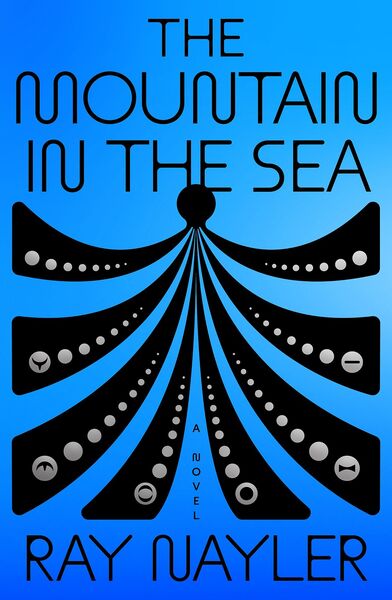I’d Like To Be
The Mountain in the Sea
By Ray Nayler

13 Jun, 2023
Ray Nayler’s 2022 The Mountain in the Sea is a stand-alone near-future tale of first contact.
In a triumph of human achievement, high ‑tech trawlers have scoured the oceans, transforming them from over-crowded seas full of thriving life to pristine deserts. As catches plummet, new ways are discovered and deployed to track down and catch the tiny remnant of a once-rich ecosystem.
While this is good news for consumers, it’s bad news for people like Eiko, kidnapped and enslaved on an automated fishing boat. Humans are slightly cheaper than new machinery.
It’s worse news for the entities living off Con Dao, for they are not human. This is a world in which humans are merely economic cogs while non-humans are simply food.
The Con Dao archipelago is one of the few remaining comparatively untouched oases of life remaining in the world’s seas. DIANIMA negotiated control of the archipelago. The local human community was relocated, replaced by the Con Dao Forward Research Post scientists like Dr. Ha Nguyen. While the area is a designated preserve, that will be insufficient to deter trawlers. Thus, the well-armed defensive array protecting Con Dao.
Con Dao’s ecosystem is sufficient to make it a precious treasure. A recent discovery reveals that it is more precious than previously known. There is a community of octopuses living offshore. While octopuses are known to be bright, there are fundamental biological barriers that make creating and maintaining culture essentially impossible for the cephalopods. This new tool using species has found a way around those barriers.
Discovery raises many questions. What triggered the sudden transition to tool use? Is it possible to bridge the communications gap between human and octopus? Most importantly, is it possible to protect the intelligent octopuses from human predation? If not, none of the other questions matter.
Elsewhere, efforts to escape the cold algorithms of the computer running Eiko’s fishing boat redirect the craft towards Con Dao and a rendezvous with the defensive array. Nor are automated fishing boats the worst threat to the archipelago. Some unknown entity, corporate or government, has set its eyes on the preserve and is working relentlessly to seize ownership.
~oOo~
The fundamental barrier between octopuses and culture is life span and reproduction. Generally speaking, octopuses have very short lifespans, often dying soon after reproducing (although some species, like the Pacific Striped Octopus, do not). This means that as bright as any octopus may be, most octopuses are essentially on their own, forced to recapitulate the discoveries of previous generations.
Eiko’s plotline exists to demonstrate that humans have been reduced to components by the economic system of the near-future. Attempts to shape one’s own destiny are confounded by the fact that decisions are made by merciless software relentlessly pursuing profit regardless of the human toll or long-term consequences. The slave masters on whom Eiko and his fellow slaves’ ire falls are as much victims of the system as Eiko, not that that doesn’t mean the slavers don’t deserve what happens to them.
The cost of the Eiko plot, however, is less time available for the Con Dai octopus plot. This is a tremendous pity, as the octopuses are fascinating and the story of their sometimes-violent interactions with the humans deserved more room. Indeed, it felt like the scientists spent more time talking about the research they wanted to do rather than actually carrying it out, squandering their limited time.
The aspect of the novel that was my primary interest — the first contact — was often relegated to the background as the story shifted back to Eiko. The events kept my attention but the ultimate effect when the final page was reached and the covers closed was a sense of incompleteness. Consequently, I found this a frustrating read1.
As I type, The Mountain in the Sea is racking up award nominations (the 2023 Nebula for Best Novel, the 2023 Kitschies Golden Tentacle for Best Debut Novel and the 2023 Locus for Best First Novel). Clearly, I am in the minority here.
The Mountain in the Sea is available here (Amazon US), here (Amazon Canada), here (Amazon UK), here (Apple Books), here (Barnes & Noble), and here (Chapters-Indigo).
1: Editor’s note: I bounced off this book hard. I’m a Buddhist. The author’s understanding of Buddhism was nil. Tibetan Buddhists are supposed to have bought a pagoda in Vietnam (why the hell would they do that?) and staffed it with robots who circumambulate chanting “Namu myoho renge kyo,” which is a chant from the Japanese Nicheren sect (and best known as a devotional practice of the Soka Gakkai cult, an offshoot of Nichiren). Tibetan monks would be chanting “Om mani padme hum.” Or perhaps Tara or Amitabha chants.
It’s also not clear why any Buddhists would want robot monks. The book says that the monks contain the memories of highly esteemed deceased human monks. Some of the robots also work in the turtle sanctuary. So why not house the memories on a server? Why not use just plain robots to maintain the turtle sanctuary? IMHO, the author was just enamored of the notion of circumambulating chanting robots. Perhaps chanting Buddhists make him think of robots?
